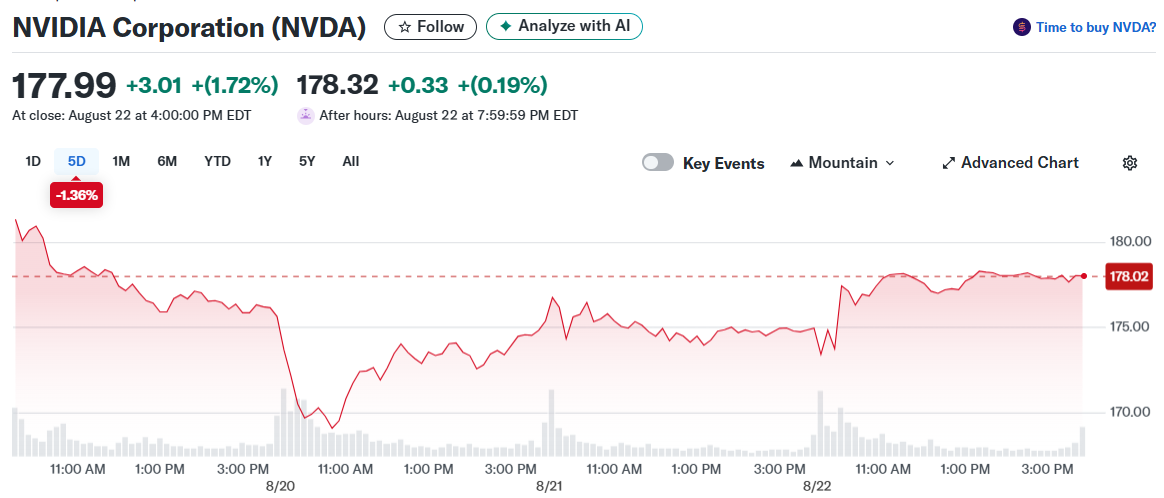TLDR
- Nvidia reports Q2 earnings Wednesday with analysts expecting record $46.45 billion revenue despite China export restrictions
- Company struck 15% revenue-sharing deal with Trump administration to resume H20 chip sales in China
- Wall Street analysts overwhelmingly bullish with 12 of 13 rating stock a “buy” and price targets up to $225
- Nvidia developing new B30A chip for China based on Blackwell architecture with 50% of flagship processor power
- China AI chip market estimated at $50 billion annually, representing major revenue opportunity for Nvidia
Nvidia faces a pivotal moment as it prepares to release second-quarter earnings Wednesday after market close. The AI chipmaker is expected to report adjusted earnings per share of $1.02 on revenue jumping over 50% year-over-year to $46.45 billion.

The earnings come as Nvidia navigates complex trade restrictions with China. Earlier this year, the company warned of an $8 billion potential hit from China export curbs. The restrictions forced Nvidia to take a $4.5 billion charge in the first quarter related to its H20 chips.
However, CEO Jensen Huang’s lobbying efforts have paid off. Nvidia recently agreed to a 15% revenue-sharing deal with the Trump administration. This agreement allows the company to resume sales of its H20 chip in China.
The H20 processors are specialized graphics processing units designed to meet strict U.S. export restrictions. They still provide computational power needed for AI processing. Sales of these China-focused chips totaled $17 billion in fiscal 2025, representing roughly 13% of total company sales.
New Chip Architecture for Chinese Market
Reports emerged this week that Nvidia is developing a new AI processor for Chinese customers. The chip, reportedly called the B30A, is based on Nvidia’s successful Blackwell architecture. Sources say it will deliver half the computational power of the flagship Blackwell B300 processor.
The 50% power reduction appears intentional. President Trump recently indicated openness to a reduced-capacity Blackwell chip. He suggested taking “30% to 50% of the computing power off” during a press conference last week.
Nvidia remains cautious in its public statements. The company said it evaluates various products for its roadmap to compete where governments allow. Everything offered requires full approval from applicable authorities and is designed for beneficial commercial use.
Wall Street Remains Bullish
Analysts express strong confidence in Nvidia’s prospects despite trade headwinds. Of 13 analysts surveyed by Visible Alpha, 12 rate the stock a “buy” with one “hold” rating. Price targets range from $155 to $225, with most above $200.
This suggests substantial upside from Friday’s close around $178. Morgan Stanley raised its target to $206 from $200, citing strong AI demand signals. UBS boosted its target to $205 from $175, while Wedbush increased its to $210 from $175.
The stock has experienced volatility this year. After hitting new all-time highs early in 2025, shares plunged 37% before recovering. Concerns about tariffs, inflation, and China chip sales fueled the historic swings.
Nvidia stock closed Wednesday just 4% below record levels. The upcoming earnings report could provide the catalyst for another rally.
Huang previously estimated China’s AI chip market could reach $50 billion annually over the next few years. This represents a potentially lucrative opportunity for the company. Wall Street projects Nvidia revenue of $200 billion in fiscal 2026, $257 billion in fiscal 2027, and $302 billion in fiscal 2028.
China previously accounted for roughly 13% of total sales. This suggests potential revenue from the country could reach $99 billion over the next three years. Most analysts likely haven’t updated models to reflect the higher revenue potential from the new agreements.
The advanced capabilities of Blackwell chips mean even scaled-back versions should command higher prices from Chinese customers. This creates additional revenue potential beyond the existing H20 chip sales


